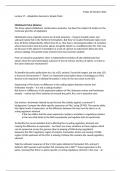Lecture notes
Biodiversity Genomics - Adaptation Genomics (Simple Traits)
- Module
- Biodiversity Genetics
- Institution
- Imperial College London (ICL)
These lecture notes provide a detailed examination of the genetic basis of simple adaptive traits, highlighting key case studies and molecular mechanisms. The lecture notes explore how genetic mutations drive adaptation in natural populations and the methodologies used to uncover these associations...
[Show more]



